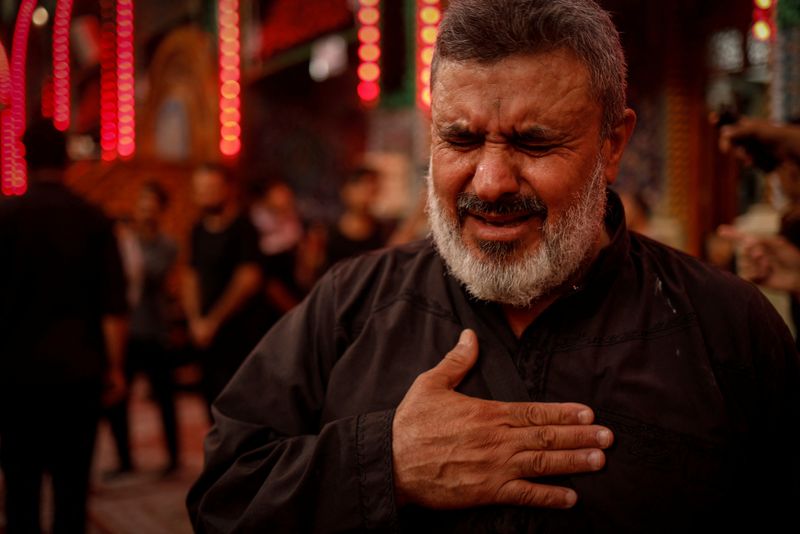
KARBALA, Iraq (Reuters) -Majid al-Kareem is poorly equipped for his 500 km pilgrimage by foot through the scorching deserts of southern Iraq. He wears sandals and black clothes that absorb the heat, and carries a wooden broom handle for a walking stick.
But suffering is the point.
His journey mourns and glorifies the Muslim Prophet Mohammad’s grandson Hussein, slain in battle nearly 1,400 years ago at the end of this very route.
Kareem begins at the furthest possible starting point, at Ras al-Bisha in southern Iraq. He stands in the sands of the Persian Gulf before setting off north towards his goal, the holy city of Karbala, where Hussein died and where his shrine now stands. Kareem will be on the road for 22 days.
It is a tiring start for the 58-year-old. The hot wind that blows through the southern Iraqi deserts and marshes, or inland from the sea, already batters him and frays a black flag he carries for the first part of the journey.
He is upbeat, however, and says his faith and resolve have never been stronger.
"I am fine, thank God. The path of Imam Hussein is the path of the free. I feel like a king on this path,” he says.
Arbaeen, meaning 40 in Arabic, is one of the most important rituals for Shi’ite Muslims. It has also become the world’s largest annual pilgrimage and dwarfs the Muslim Hajj pilgrimage to Saudi Arabia’s Mecca.
The event marks 40 days after the death of Hussein, who was killed by the army of Muslim Caliph Yazid ibn Muawiya.
SHI'ITE-SUNNI SPLIT
Shi’ites, who believe the line of caliphs should follow the prophet’s blood line while Sunnis believe it should be decided by consensus, mark Hussein’s death with mourning in the streets.
The Shi’ite-Sunni split has divided the Middle East to different degrees at different points in history. The U.S. invasion of Iraq in 2003 exacerbated sectarian tensions that fuelled a civil war in Iraq, home to a Shi’ite majority but with a large Sunni population.
The toppling of Saddam Hussein during that invasion, however, also allowed Shi’ites to restart rituals that the Iraqi president had restricted.
Kareem made his first full pilgrimage after Saddam was ousted, and has kept up the tradition every year since. “This is my 18th time,” he says, proudly.
Arbaeen is also a display of Iraqi hospitality. Volunteers hand out cups of thick black sugary tea along roadsides and feed tired, hungry pilgrims in tents. Mosques and religious halls known as Husseiniyas open their doors to travellers to sleep and rest.
Kareem relies on welcoming strangers to make his journey. He also meets family members along the way who join him for parts of the walk.
As his pilgrimage nears its end, the sight of Karbala and the Hussein shrine is a boost. He jostles with other pilgrims who throng the shrine. Visited by more than 20 million pilgrims each year, it is housed within a vast, golden-domed mosque decorated with ornate entrances, wooden gates and glass.
Kareem says a prayer as he gets close.
He has reached the holy city a couple of days ahead of the culmination of Arbaeen on Friday.
"Every year our love and longing for Imam Hussein grows stronger,” he says.
(Photography and reporting by Alaa al-Marjani; Writing by John Davison; Text editing by Andrew Cawthorne; Photo editing by Cynthia Karam)

 Reuters US Top
Reuters US Top
 AlterNet
AlterNet The List
The List The Daily Record Weird News
The Daily Record Weird News FOX News Videos
FOX News Videos IMDb Movies
IMDb Movies America News
America News